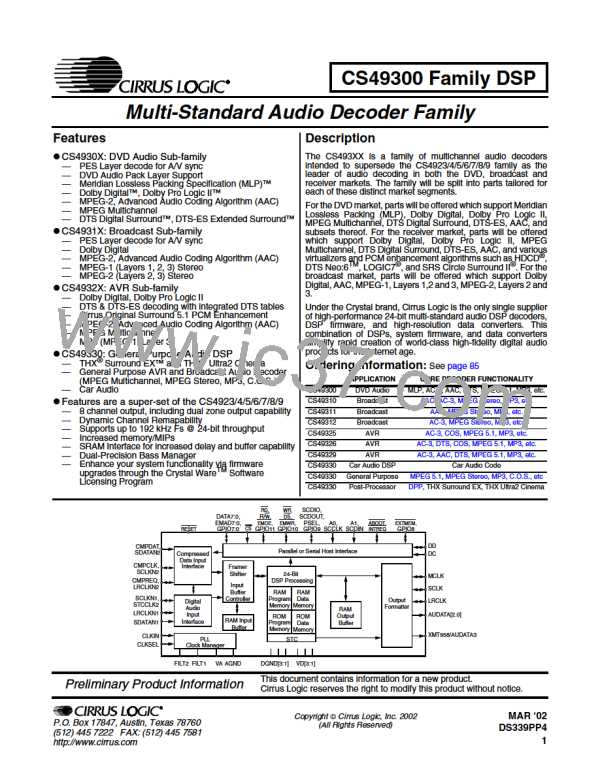CS49300 Family DSP
The timing diagram in Figure 24, "I2C® Timing"
on page 40 shows the relative edges of the control
lines for an I C read and write.
high for one period of SCCLK and then goes low
again before the end of the read cycle.
2 ®
In case (1) the host should perform a read operation
as discussed in the previous sections.
6.1.3. INTREQ Behavior: A Special Case
In case (2) an unsolicited message arrives before
the second to last SCCLK of the final byte transfer
of a read, forcing the INTREQ pin to remain low.
In this scenario the host should continue to read
from the CS493XX without a stop/start condition
or data will be lost.
When communicating with the CS493XX there are
two types of messages which force INTREQ to go
low. These messages are known as solicited
messages and unsolicited messages. For more
information on the specific types of messages that
require a read from the host, one of the application
code user’s guides should be referenced.
In case (3) an unsolicited message arrives between
the second to last SCCLK and the last SCCLK of
the final byte transfer of a read. In this scenario,
INTREQ will transition high for one clock (as if the
read transaction has ended), and then back low
(indicating that more data has queued). This final
case is the most complicated and shall be explained
in detail.
In general, when communicating with the
CS493XX, INTREQ will not go low unless the
host first sends a read request command message.
In other words the host must solicit a response from
the DSP. In this environment, the host must read
from the CS493XX until INTREQ goes high again.
Once the INTREQ pin has gone high it will not be
driven low until the host sends another read
request.
There are two constraints which completely
characterize the behavior of the INTREQ pin
during a read. The first constraint is that the
INTREQ pin is guaranteed to remain low until the
second to last SCCLK (SCCLK number N-1) of the
final byte being transferred from the CS493XX
(not necessarily the second to last bit of the data
byte). The second constraint is that once the
INTREQ pin has gone high it is guaranteed to
remain high until the rising edge of the last SCCLK
(SCCLK number N) of the final byte being
transferred from the CS493XX (not necessarily the
last bit of the data byte). If an unsolicited message
arrives in the window of time between the rising
edge of the second to last SCCLK and the final
SCCLK, INTREQ will drop low on the rising edge
of the final SCCLK as illustrated in the functional
When unsolicited messages, such as those used for
Autodetect, have been enabled, the behavior of
INTREQ is noticeably different. The CS493XX
will drop the INTREQ pin whenever the DSP has
an outgoing message, even though the host may not
have requested data.
There are three ways in which INTREQ can be
affected by an unsolicited message:
1) During normal operation, while INTREQ is
high, the DSP could drop INTREQ to indicate an
outgoing message, without a prior read request.
2) The host is in the process of reading from the
CS493XX, meaning that INTREQ is already low.
An unsolicited message arrives which forces
INTREQ to remain low after the solicited message
is read.
2 ®
timing diagrams shown for I C and SPI read
cycles.
2 ®
INTREQ behavior for I C communication is
3) The host is reading from the CS493XX when the
unsolicited message is queued, but INTREQ goes
illustrated in Figure 24, "I2C® Timing" on page
2 ®
40. When using I C communication the INTREQ
pin will remain low until the rising edge of SCCLK
DS339PP4
39

 CIRRUS [ CIRRUS LOGIC ]
CIRRUS [ CIRRUS LOGIC ]